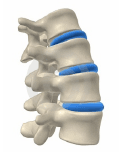HERNIATED INTERVERTEBRAL DISC

Our spine consists of 33 - 34 vertebrae, one above the other. Between the vertebrae are discs which play the role of joints by supporting the vertebrae and allowing them to have mobility; with shapes changes during movements they ensure equal pressure distribution on the underlying vertebra.
The intervertebral disc is an apparently simple structure that performs a very important function: it allows movement between the vertebrae in order for the spine to be able to bend and rotate. At the same time it functions as a “shock absorber” between vertebrae by absorbing shock.
The disc consists of a fibrous outer ring of strong bundles of collagen fibers that firmly connect the vertebrae as well as an inner part that surrounds the nucleus pulposus. Nucleus pulposus consists of a network of delicate collagenous fibers and complex masses of polysaccharide and protein in the form of gel.
The disc by its nature lacks its own vessels and progressively tends to dehydrate, shrink, to become less flexible and to degenerate. This process begins from about the age of 12 years and it becomes apparent at the age of 30. Regular exercise is the main way of disc maintenance and halting of the ageing process and disc degeneration.
The herniated intervertebral disc was announced for the first time in Boston by Mixter & Barr in 1934 and is scientifically described as “the projection of a part of the disc into the spinal canal”. The formation of a hernia causes pressure on the adjacent nerve root, causing intense pain. The acute disc damage is called radiculopathy whereas chronic damages are called degenerative disc diseases or disc arthropathy and gradually lead to spondylarthritis (a disease where the vertebrae “rub” together).



